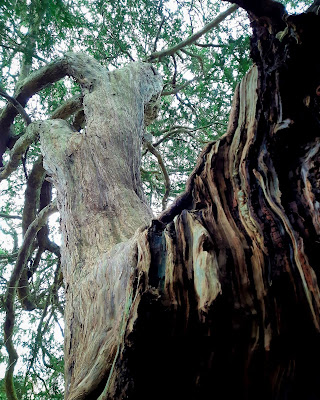It's a bit shaming to admit it had taken me so long to travel no more than a dozen miles to visit the ancient sweet chestnut tree at Tortworth in South Gloucestershire.
Even so, I delayed our meeting a little longer by popping into the St Leonard's Church, with its elegant but strangely disproportionate tower.
The church has clearly been heavily restored and not a lot of its past remains.
One of the two Throckmorton tombs in the South Chapel made a useful table for a nativity display.
The font is Norman, 12th century, with a 17th century cover ...
... and there's some mediaeval glass in the traceries of a couple of windows, some of which depicts King Edward IV and the sun emblem of the House of York.
The famous Tortworth chestnut is nearby and fenced off, presumably for the health and safety of both visitor and tree.
Written records go back to the 12th century, when the tree was a boundary marker; legend dates it to the reign of King Egbert in 800AD.
 It's difficult to measure its girth as many of its branches have rooted to become trees themselves. In fact, it looks more like woodland than a tree.
It's difficult to measure its girth as many of its branches have rooted to become trees themselves. In fact, it looks more like woodland than a tree.It was good to get to see it at last.

My other two remarkable trees dictated a detour en route to the south coast. The journey was ornamented by seven red kites flying over the motorway. Always a good sign, and the first yew tree in the churchyard of St Peter's in Tandridge, Surrey, didn't disappoint.
Unsurprisingly, the church was locked between services. It looked interesting in an Arts and Crafts Movement sort of way and I should like to visit on a non working day some time.
The churchyard had some interesting tombs in it, though, and loads of squirrels floofing about. As for the yew, it's believed to have been struck by lightning in the mid-19th century and was declared to be in a state of rapid and terminal decay around that time ...
 ... but here is it, magnificent and thriving. As far as we know, yews are the oldest living entities in Europe and Asia. This one is hollow inside and has three mighty trunks that have grown around the decayed central one that fell, probably, centuries ago. As for its age, no one really knows. Over 1000 years seems a reasonable supposition; possibly even pre-Saxon, the remnant of a Celtic tree cult.
... but here is it, magnificent and thriving. As far as we know, yews are the oldest living entities in Europe and Asia. This one is hollow inside and has three mighty trunks that have grown around the decayed central one that fell, probably, centuries ago. As for its age, no one really knows. Over 1000 years seems a reasonable supposition; possibly even pre-Saxon, the remnant of a Celtic tree cult. We didn't see the sign that says not to walk under it until we'd walked under it. (Very respectfully, of course.)
It was lovely inside, with mosaic and painted frescoes in the Pre-Raphaelite style on the east wall, providing colour and light.
It also has a 13th century font with mediaeval graffiti ...
... more graffiti in the porch doorway, as well as deep grooves caused by bowmen sharpening their arrow heads ...
... and presumably a Christmas gift of beer stashed in the pulpit.
Outside, I spotted this striking headstone from the 1960s with its beautiful wheatsheaves, symbolising both the harvesting of life and resurrection ...
... and we paused to listen to a pair of extremely raucous jays having a right old barney with the magpies and the crows in the meadow over the back.
But the yew, the yew ... !
Here it is, reaching out ...
... and thoroughly bewitching.
This is a very very old tree indeed. In the early nineteenth century it was fitted out as a room with door, table and chairs, during which a cannon ball from the civil war was discovered embedded in its wood.
A storm struck the tree in 1845 and brought down the 'roof'.
Inside, the growth of new wood on old is simultaneously architectural and grotesque.
It's almost as if it has grown its own daemons.
As for its age ... the Parish Council claims 4000 years, but they would, wouldn't they? Again, it's impossible to know, but it does seem likely that it's at least in its second millennium.
So how do you end your pilgrimage to three timeless trees that have witnessed so much social history and probably don't care much about the preoccupations of its short-lived protagonists?
With something that is equally unfathomable, I think.
Rock doves





































Hello! Ah, trees! How lovely, indeed. But the Sea,the Sea
ReplyDeleteHello, you! Hope you're doing OK xxx
Delete